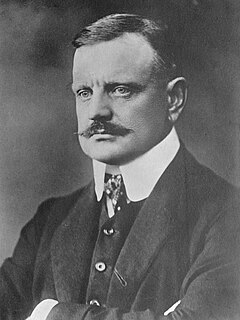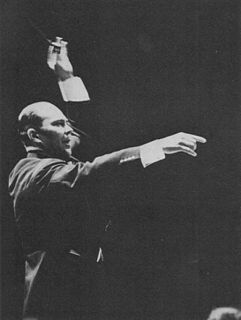Related Research Articles

Helsinki is the capital, primate, and most populous city of Finland. Located on the shore of the Gulf of Finland, it is the seat of the region of Uusimaa in southern Finland, and has a population of 656,250. The city's urban area has a population of 1,268,296, making it by far the most populous urban area in Finland as well as the country's most important center for politics, education, finance, culture, and research; while Tampere in the Pirkanmaa region, located 179 kilometres (111 mi) to the north from Helsinki, is the second largest urban area in Finland. Helsinki is located 80 kilometres (50 mi) north of Tallinn, Estonia, 400 km (250 mi) east of Stockholm, Sweden, and 300 km (190 mi) west of Saint Petersburg, Russia. It has close historical ties with these three cities.

Jean Sibelius was a Finnish composer and violinist of the late Romantic and early-modern periods. He is widely recognized as his country's greatest composer, and his music is often credited with having helped Finland develop a national identity during its struggle for independence from Russia.

Paavo Allan Engelbert Berglund was a Finnish conductor and violinist.

The Sibelius Academy is part of the University of the Arts Helsinki and a university-level music school which operates in Helsinki and Kuopio, Finland. It also has an adult education centre in Järvenpää and a training centre in Seinäjoki. The Academy is the only music university in Finland. It is among the biggest European music universities with roughly 1,700 enrolled students.

Finlandia, Op. 26, is a tone poem by the Finnish composer Jean Sibelius. It was written in 1899 and revised in 1900. The piece was composed for the Press Celebrations of 1899, a covert protest against increasing censorship from the Russian Empire, and was the last of seven pieces performed as an accompaniment to a tableau depicting episodes from Finnish history. The premiere was on 2 July 1900 in Helsinki with the Helsinki Philharmonic Society conducted by Robert Kajanus. A typical performance takes between 7½ and 9 minutes depending on how it is performed.

Arabianranta, sometimes simply Arabia, is a residential part of Helsinki, Finland. It is bound by Vanhankaupunginlahti bay from east, and connects to neighboring boroughs of Vanhakaupunki in north, Hermanni in south and Toukola and Kumpula in west. It is part of the greater Toukola region.

Linda Cullberg Lampenius, better known by her maiden name Linda Lampenius and international stage name Linda Brava, is a Finnish classical concert violinist. Named as one of the most versatile and accomplished players of her generation, Brava has also performed pop, rock, folk, techno, film, jazz, and world music, among others.

Georg Lennart Schnéevoigt was a Finnish conductor and cellist, born in Vyborg, Grand Duchy of Finland, which is now in Russia, to Ernst Schnéevoigt and Rosa Willandt.

Robert Kajanus was a Finnish conductor, composer, and teacher. In 1882, he founded the Helsinki Orchestral Society, Finland's first professional orchestra. As a conductor, he was also a notable champion and interpreter of the music of Jean Sibelius.

Pekka Kuusisto is a Finnish musician.

Tapani Rinne is a Finnish musician, composer, record producer and sound designer, who is known for his experimental and innovative style with the clarinet and saxophone. It has earned him a reputation as one of the most respected and unique Nordic instrumentalists.
John Gunnar Rafael Storgårds is a Finnish violinist and conductor.
Professor Géza Ellák Jenő Szilvay is a Hungarian violinist, teacher and conductor. He is the brother of the cellist Csaba Szilvay and the father of the violinist Réka Szilvay. With his brother Csaba Szilvay he founded the Helsinki Strings, a youth orchestra, in 1972. They conducted it until they retired in 2010.

The Helsinki Music Centre is a concert hall and a music center in Töölönlahti, Helsinki. The building is home to Sibelius Academy and two symphony orchestras, the Finnish Radio Symphony Orchestra and the Helsinki Philharmonic Orchestra.
The following is a timeline of the history of the city of Helsinki, Finland.

The University of the Arts Helsinki, also known as Uniarts Helsinki, is a Finnish arts university that was launched in the beginning of 2013. Apart from a few exceptions, it is the only university in Finland that provides education in the fields it represents.
Ihme Contemporary Art Festival is a yearly festival for contemporary art produced by Pro Arte Foundation Finland. The festival includes a public work of art, a varied programme of events around the artwork, and educational art projects. Ihme Project, commissioned by the Festival, is to be realised in the public realm. A varied Festival programme ranging from artist talks to film screenings opens up the Ihme Project for discussion and debate and is free to attend. Ihme also offers an art education programme, Ihme School, with various activities. The word "ihme" means a wonder or a miracle in Finnish.
Tero Saarinen Company is a dance group founded in 1996 by its director, the Finnish dance artist and choreographer Tero Saarinen. The group's repertoire consists mainly of choreographies by Saarinen. The Company is based in Helsinki, although it mainly performs abroad. The group's rehearsal space and office are in the Alexander Theatre, where it also performs some of its small to midscale works.
Kari Antero Turunen, is a Finnish artistic director, choral conductor, ensemble tenor, and music scholar and lecturer.
Jutta Seppinen is a Finnish conductor and mezzo-soprano.
References
- ↑ "Helsingin juhlaviikot". www.helsinginjuhlaviikot.fi (in Finnish). Retrieved 2017-02-20.
- ↑ "Festival History Re-visited". Archived from the original on 2011-07-16.
- 1 2 "Info: Helsingin juhlaviikot" . Retrieved 19 February 2017.
- ↑ "Venues". Archived from the original on 2011-07-16.